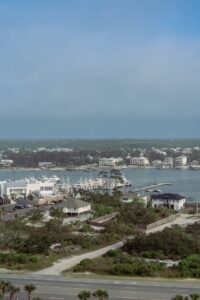Boating from Canada to Florida for the winter is a popular adventure for many Canadians, often referred to as the “snowbird migration” for boaters. Here’s a guide that covers the key aspects of this journey, from preparations to navigating beyond Florida
Preparations before you head to Florida or the Caribbean
Before embarking on a long voyage from Canada to Florida, thorough preparation is essential:
- Ensure all your documentation is up to date: including boat registration, operator’s license, passports, health insurance and visas if needed. If you plan to travel to the Bahamas or other Caribbean islands, you’ll need additional documentation.
- Vessel preparation: Conduct a comprehensive inspection of your boat. Ensure the engine, navigation systems, safety equipment (including life jackets, flares, fire extinguishers, and first aid kits), and communication devices are in top condition. It’s wise to have spare parts for essential equipment.
- Weather planning: Plan your departure according to the weather. Winter storms can be a significant threat in the Atlantic, so monitor forecasts and plan to avoid rough seas.
- Provisioning: Stock up on food, water, and other supplies. The distance between ports can be significant, and you may encounter delays. Ensure you have enough medications for your entire trip.
Trailering the vessel or navigating coastal waters
When deciding how to get your boat to Florida, you have two main options:
- Trailering the vessel: If your boat can be put on a trailer, this can be a faster and often less stressful way to get your boat south. It also saves wear and tear on the vessel. You can tow your boat to a launch point in the southern United States (like Virginia or North Carolina) and continue your journey on water from there. Ensure your trailer is in excellent condition, and your towing vehicle can handle the load. Check road restrictions for oversized loads and plan your route to avoid congested urban areas. Another option is to have your boat shipped to your port of choice.
- Navigating coastal waters: The more adventurous route is to sail or motor your boat down the East Coast. The Intracoastal Waterway (ICW) is a popular route for this journey, offering protected waters most of the way from Norfolk, Virginia, to the Florida Keys. Navigating the ICW requires constant attention due to changing water depths, tides, and currents. Be aware of bridge schedules and restricted operating hours in some areas. Fuel stops and marinas are plentiful, but it’s essential to plan your stops.
Tip: Join a Cruisers Forum to garner tips from experienced boaters that have travelled from Canada to Florida.”
Insurance coverage
Your insurance needs will change when boating in the U.S. and beyond.
- Review your policy: Ensure your existing boat insurance covers you for the entire journey, including while in U.S. waters and possibly the Caribbean. Some policies may have geographic limits, so you may need an endorsement or rider for extended coverage. PMU offers a specific policy for Southern Navigation routes that have multiple navigational zones stretching from the Atlantic Eastern Seaboard all the way to Southern Caribbean Sea, and a Small Vessel extension for inland North American waterways, and coastal waters up to 3 miles from shore. For more information, visit our Navigational Territories page.
- Liability and health coverage: Verify that your policy includes adequate liability coverage in the U.S. Additionally, check your health insurance to see if it covers you while traveling or if you need additional coverage.
- Hurricane season: If you plan to stay in Florida or the Bahamas during hurricane season, ensure your policy covers storm damage and that you comply with any policy requirements, such as hauling the boat out of the water during a named storm.
“Named Storm/Hurricane: All losses caused directly or indirectly by any Named Windstorms named by the National Oceanic and Atmospheric Administration or hurricane are not covered in navigational territories south of 40 degrees North Latitude.”
Navigational areas beyond Florida

Once you reach Florida, you have several options for further exploration:
- Florida Keys: The Florida Keys offer beautiful cruising grounds with clear waters and abundant marine life. The ICW extends down to Key West, providing relatively protected waters for most of the trip.
- Bahamas: Many boaters continue from Florida to the Bahamas. The crossing from Miami to Bimini is about 50 miles. The Bahamas offers some of the best cruising in the world, but it requires careful planning for customs, immigration, and provisioning.
- Caribbean: Adventurous boaters may continue further south to the Caribbean islands. This requires a more substantial commitment, including planning for longer passages, potential open ocean navigation, and more complex customs and immigration procedures in multiple countries.
- Gulf of Mexico: Heading west around the tip of Florida opens to the Gulf Coast, with destinations like the Florida Panhandle, Alabama, and the coast of Texas. This route offers warmer winter cruising grounds, with a mix of marinas and anchorages.
Heading south for the winter is a fantastic way to escape the Canadian cold and enjoy extended boating opportunities. Whether you choose to trailer your vessel or navigate the coastal waters, careful planning and preparation will ensure a safe and enjoyable journey.
Resources boating from Canada to Florida
Dockwa: Southern intracoastal waterway marinas
Safe Harbour Insurance: Boating adventures in the Caribbean
Waterway Guide
PMU : Secure your boat for a hurricane
ITA Yachts: How to plan your boat trip from Quebec to Florida
Pats Boating in Canada: Cruising South
US Custom & Border Protection: Pleasure Craft Overview








